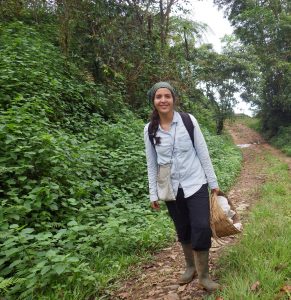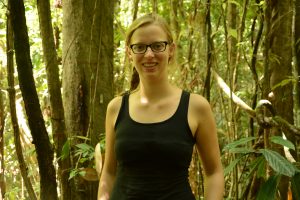The Association for Tropical Biology and Conservation (ATBC) recognizes the exceptional research of our students and early career scientists with awards for outstanding presentations at the ATBC’s annual meeting. The Luis F. Bacardi Award for Advances in Tropical Conservation is awarded to the individual receiving their Ph.D. no more than 5 years before the meeting date who gives the best oral presentation. This award was established in 2005 with an endowment from the Lubee Bat Conservancy, an international non-profit organization based in Gainesville, Florida, that was founded in 1989 by the late Luis F. Bacardi and is dedicated to protecting biological diversity through the conservation of fruit- and nectar-feeding bats. The Alwyn Gentry Presentation Awards are in recognition of the outstanding oral and poster presentations by students at the ATBC’s annual meeting. Alwyn H. Gentry’s legacy to tropical biology was not limited to the study of the diversity and conservation of tropical plants—he was a caring and supportive mentor to students from all over the Americas. These awards are therefore in remembrance and recognition of the contributions of this singular scientist, colleague, mentor, and friend.
On behalf of the ATBC we would like to thank the early-career scientists that presented their work at the 2017 ATBC Meeting in Mérida, extend our gratitude to the many meeting delegates who served as judges, and congratulate the following recipients for their outstanding presentations.
Kyle Harms and Bettina Engelbrecht
Gentry and Bacardi Award Co-Chairs
2017 Alwyn Gentry Award for Best Oral Presentation
Canopy connectivity increases ant-provided biocontrol services in a tropical agroforest. Estelí Jimenez-Soto, Jonathan Morris, Deborah Letourneau, Stacy M. Philpott. In tropical ecosystems, ants are among the most abundant and biodiverse taxonomic groups, and play important ecological roles such as predation, herbivory and seed dispersal (Longino et al. 2002). Canopy connections are important structural resources for arboreal ant communities, because they facilitate resource discovery (Powell et al. 2011, Clay et al. 2010, Yanoviak and Schnitzer 2013). In agroforestry systems, ants provide predation services, but especially in more intensive systems, with fewer trees, a lack of canopy connectivity between shade trees, or between shade trees and crop plants may hinder ant abilities to provide ecosystem services. We examined whether increasing canopy connectivity in coffee plantations increases ant activity and enhances biological control of the coffee berry borer, the most devastating insect pest of coffee. The present study was conducted in 20 sites within a 300 ha shaded coffee plantation in the Soconusco region in Chiapas, Mexico. The coffee plantation is located at 1100 m a.s.l. in the Sierra Madre Mountains. We used jute strings to create canopy connections between Inga micheliana shade trees containing Azteca sericeasur ant nests and coffee plants and then compared ant activity and coffee berry borer removal before and after placement of the strings, and on coffee plants with and without strings. We performed Generalized Linear Models (GLM) and Generalized Linear Mixed Models (GLMM). The models considered site as a random factor and were performed using the ‘lme4’ and ‘MASS’ packages in R. Our results show that ant activity increases after the placement of strings in both treatment and control plants, as well as ant activity on trees. However, connected coffee plants had a significantly higher ant activity than treatment plants. This result could be explained by the relatively easy access to these linear and narrow pathways and higher recruitment rates, as has been shown in previous studies (Clay et al. 2010). The increase in ant activity could explain a higher rate of prey capture observed in connected coffee plants. We demonstrate that favouring connectivity and structural complexity at the local scale, by artificially adding canopy connections in the arboreal substrate, promotes ant activity on coffee plants, favors resource discovery and therefore increases coffee berry borer removal.
2017 Alwyn Gentry Award for Best Poster Presentation
Landowners reveal different expectations about a forest certificate trading scheme. Marta Lisli Giannichi, Martin Dallimer, Timothy R. Baker, and Guy Ziv. In tropical countries there are a variety of schemes to promote compensation for environmental damage and forest loss. For instance, tradable permits are now being applied to the context of forest and biodiversity conservation. Landowners who need to compensate for over deforestation (hereafter as buyers) may trade with landowners who had forgone their deforestation rights (hereafter as sellers). Significant research has focused on factors influencing participation (such as payment value, contract duration, access to information) of landowners acting as sellers. Less is known, however, if these factors are of the same importance for potential buyers. We used Q-methodology to identify views and perceptions of conservation sellers and buyers within the forest certificate trading scheme in Brazil, the “Environmental Reserve Quota” (Portuguese acronym, CRA). Q-methodology identifies and clusters individuals according to distinct perceptions of a topic. Using a data reduction technique (PCA or Centroid Factor Analysis), analysis reveals factors which represent groups of participants who presented a similar sorting pattern. From our findings we developed a “trade compatibility index” to examine what factors act as barriers for trade for both buyers and sellers. A total of 35 sellers and 24 buyers were interviewed. The analysis revealed three distinct perceptions for both sellers and buyers. While two sellers’ sub-groups showed strong conservation values, each of them state different motivations to participate. Only one buyers’ subgroup demonstrated a concern for conservation. Two subgroups did not consider participation within CRA as an appropriate forest loss compensation strategy for them. The compatibility index illustrated that expectations on contract duration and price are the main barriers avoiding trade between sellers and buyers. Our results suggest that CRA evokes different responses from sellers and buyers. In particular, expectations around contract duration appear to be the most prominent barrier to effective trade. We relate these findings to other long-term compensation options available for buyers that act as strong competitors and, therefore, keep buyers and sellers apart. Finally, we propose some policy-relevant insights that could potentially reduce the scheme barriers and make it attain its conservation goals.








